
Nathaniel Bacon was an English merchant adventurer who emigrated to the Virginia Colony, where he sat on the Governor's Council but later led Bacon's Rebellion. The Rebellion was briefly successful; but after Bacon’s death from dysentery the rebel forces collapsed.
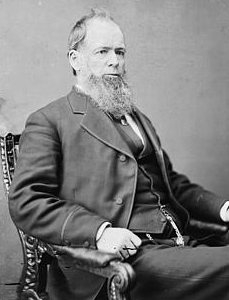
Nathaniel Herbert Claiborne was a nineteenth-century Virginia lawyer and planter, as well as an American politician who served in both houses of the Virginia General Assembly and in the United States House of Representatives (1825-1837).
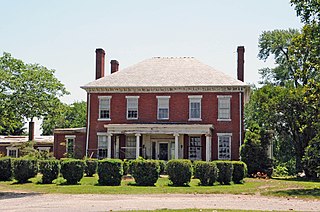
Varina Farms, also known as Varina Plantation or Varina Farms Plantation or Varina on the James, is a plantation established in the 17th century on the James River about 10 miles (16 km) south of Richmond, Virginia. An 820-acre (330 ha) property was listed on the National Register of Historic Places in 1977 as "Varina Plantation". At that time it included two contributing buildings and one other contributing site.

Elsing Green Plantation, a National Historic Landmark and wildlife refuge, rests upon nearly 3,000 acres (1,200 ha) along the Pamunkey River in King William County, Virginia, a rural county on the western end of the state's middle peninsula, approximately 33 miles (53 km) northeast of the Richmond. The 18th-century plantation, now owned by the Lafferty family, has been in continuous operation for more than 300 years. In addition to the plantation house, dependency buildings and cultivated land, Elsing Green includes 2,454 acres (993 ha) of surrounding farmland, forest and marsh land. Elsing Green has been on the Virginia Landmarks Register and the National Register of Historic Places since 1969, and received formal National Historic Landmark status in 1971.

Lower Brandon Plantation is located on the south shore of the James River in present-day Prince George County, Virginia.
Nathaniel West of Poplar Neck was a planter, military officer and politician of the British Colony and Dominion of Virginia who was one of the first two representatives for King William County in the House of Burgesses, and later represented New Kent County in that legislative assembly.

Lexington was an 18th-century plantation on Mason's Neck in Fairfax County, Virginia, United States. The estate belonged to several generations of the Mason family, and is now part of Mason Neck State Park.
The Edmund Ruffin Plantation, also known as Marlbourne, is a U.S. National Historic Landmark in Hanover County, Virginia, 11 miles (18 km) northeast of Richmond.

Carter Hall was the Millwood, Virginia, USA estate of Lt. Col. Nathaniel Burwell (1750–1814). It is located in the upper Shenandoah Valley, off Virginia Route 255 northeast of Millwood. The estate includes a grand plantation house, a great lawn, and terraced gardens, and has panoramic views in all directions. It is listed on the National Register of Historic Places.
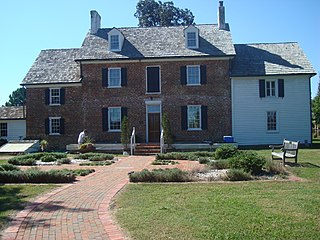
Ferry Plantation House, or Old Donation Farm, Ferry Farm, Walke Manor House, is a brick house in the neighborhood of Old Donation Farm in Virginia Beach, Virginia. The site dates back to 1642 when Savill Gaskin started the second ferry service in Hampton Roads to carry passengers on the Lynnhaven River to the nearby county courthouse and to visit plantations along the waterway. A cannon was used to signal the ferry, which had 11 total stops along the river. The first ferry service was started nearby by Adam Thoroughgood.

Windsor Shades is located on the Pamunkey River in Sweet Hall, Virginia, United States. It is listed on the National Register of Historic Places. Archeological native artifacts found on the property surrounding the house suggest it was the site of Kupkipcok, a Pamunkey village noted on John Smith's 1609 map.
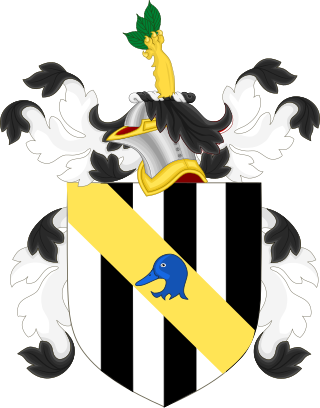
The Burwells were among the First Families of Virginia in the Colony of Virginia. John Quincy Adams once described the Burwells as typical Virginia aristocrats of their period: forthright, bland, somewhat imperious and politically simplistic by Adams' standards. In 1713, so many Burwells had intermarried with the Virginia political elite that Governor Spotswood complained that " the greater part of the present Council are related to the Family of Burwells...there will be no less than seven so near related that they will go off the Bench whenever a Cause of the Burwells come to be tried."

Nathaniel Burwell was an American politician and plantation owner. Perhaps the most distinguished of five men of that name to serve in the Virginia General Assembly before the American Civil War, this Nathaniel Burwell won election to the Virginia House of Delegates as well as the Virginia Ratifying Convention, and also served as the county lieutenant for the James City County militia.

Mayfield Cottage is a historic plantation house located near the grounds of Central State Hospital near Petersburg, Dinwiddie County, Virginia. Believed to be the oldest existing brick house in Dinwiddie County, it was built around 1750 and the residence of Robert Ruffin until 1769, when he moved to King William County. From 1885, the property was used by the hospital for its headquarters. The house remained part of the hospital complex until 1969. It was moved from its original site about .5 miles (0.80 km) to the southeast of the present site in 1969.

Providence Plantation and Farm, also known as Fogg House and Farm, is a historic plantation house located near Newtown in King and Queen County, Virginia. The two story, 3-bay Federal style brick main house was built about 1826, and expanded circa 1840. Also on the privately-held property, demonstrating the changes over time as the plantation which once encompassed about 1299 acres shrunk to the listed 6.47 acres, are the contributing two-story Reconstruction-era granary and carriage house, and Great Depression-era hen laying house, two-story sweet potato shed, and mechanic's shop.

Aberdeen is a historic plantation house located several miles north of Disputanta, Prince George County, Virginia. It was built sometime between 1790 and 1810, by Thomas Cocke. In 1790 Thomas inherited a 1,685-acre portion of his father's estate, Bonnacord, which he named "Aberdeen." Thomas's brother, John P. Cocke, inherited the remainder of Bonnacord. Thomas married Sarah Colley, daughter of Nathaniel and Martha Batte Colley of Tar Bay Plantation located about five miles west of Bonnacord.
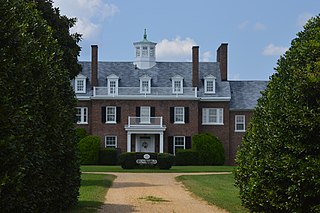
Bushfield, also known as Bushfield Manor, is a historic 2+1⁄2-story Flemish bond, 18th century brick Colonial Revival mansion located in Mount Holly, Westmoreland County, Virginia.

Boldrup Plantation Archeological Site is a historic archaeological site located at Newport News, Virginia. A modern residential development has succeeded the 17th-century plantation. Three successive colonial governors lived at Boldrup : John Harvey, Samuel Stephens (1629-1669) and William Berkeley (1605-1677). The last owned it through his wife, Frances Culpeper Berkeley, who with her new husband sold it to another member of the Virginia Governor's Council William Cole. Although it remained in the Cole family for another two generations, his namesake grandson William Cole III, advertised it for sale in 1776 and again in 1782, by which time he was living at Buckland plantation in Charles City County, which he had also inherited. Soon thereafter, Boldrup was owned by Judge Richard Cary, who was married to Mary Cole, daughter of William Cole Jr. and lived at Peartree Hall nearby, and at his death bequeathed it to his son Miles Cary. The Cary family owned several nearby plantations in Warwick and adjoining counties, including Richneck, Marshfield and Windmill Point, but never resided at Boldrup.




















